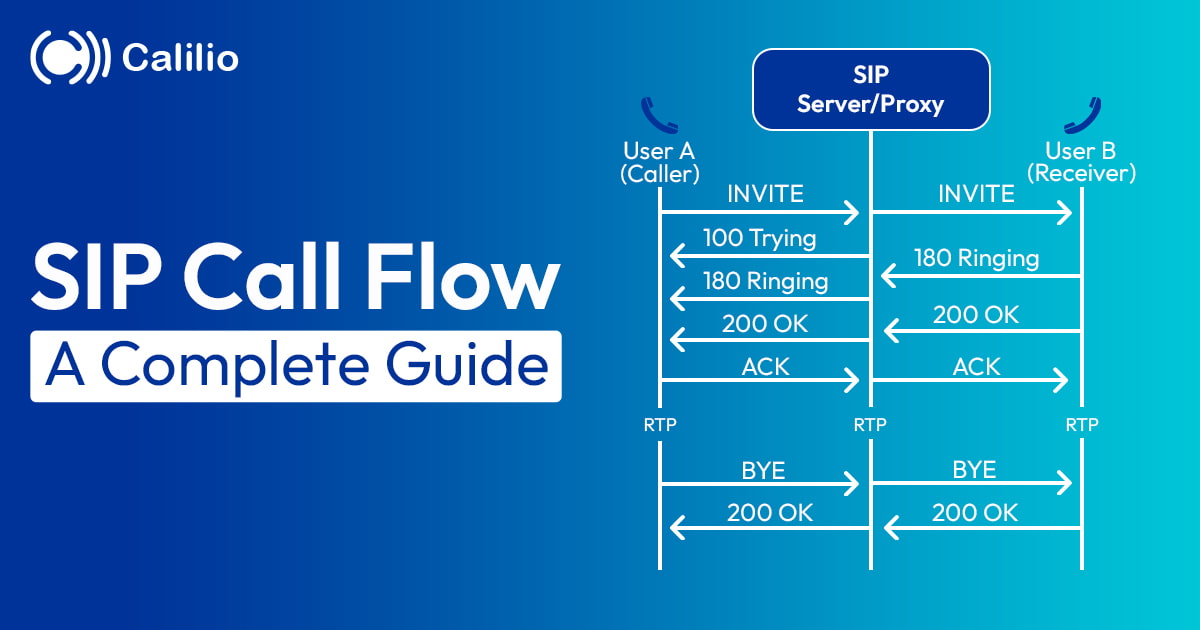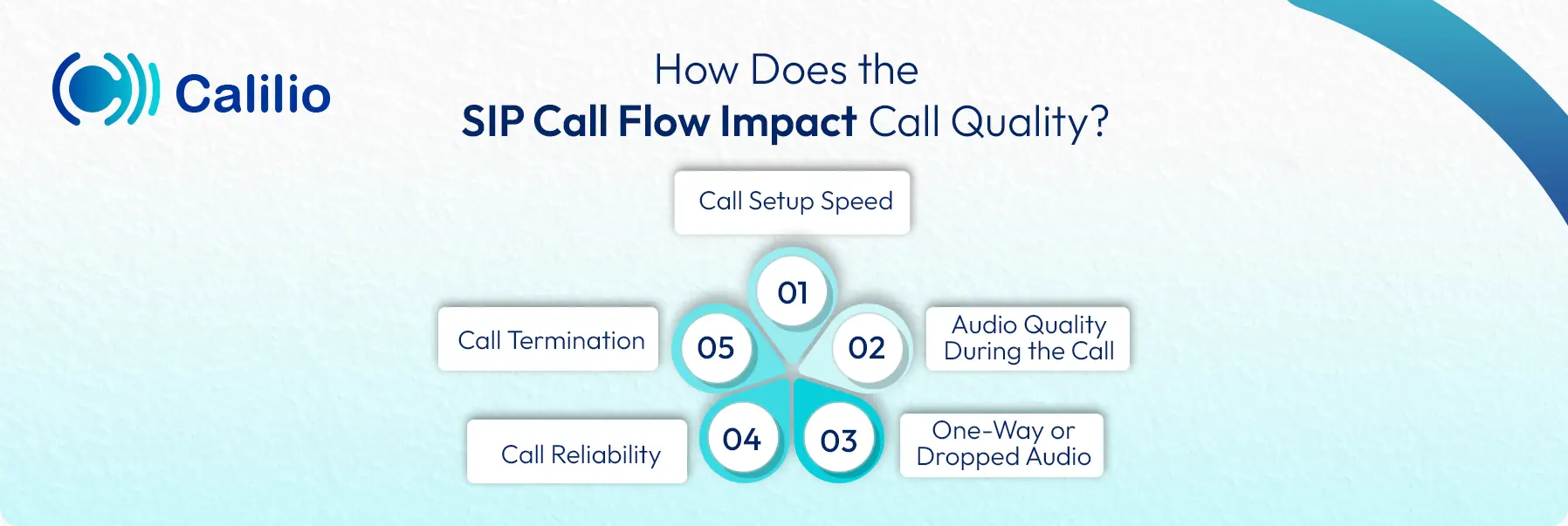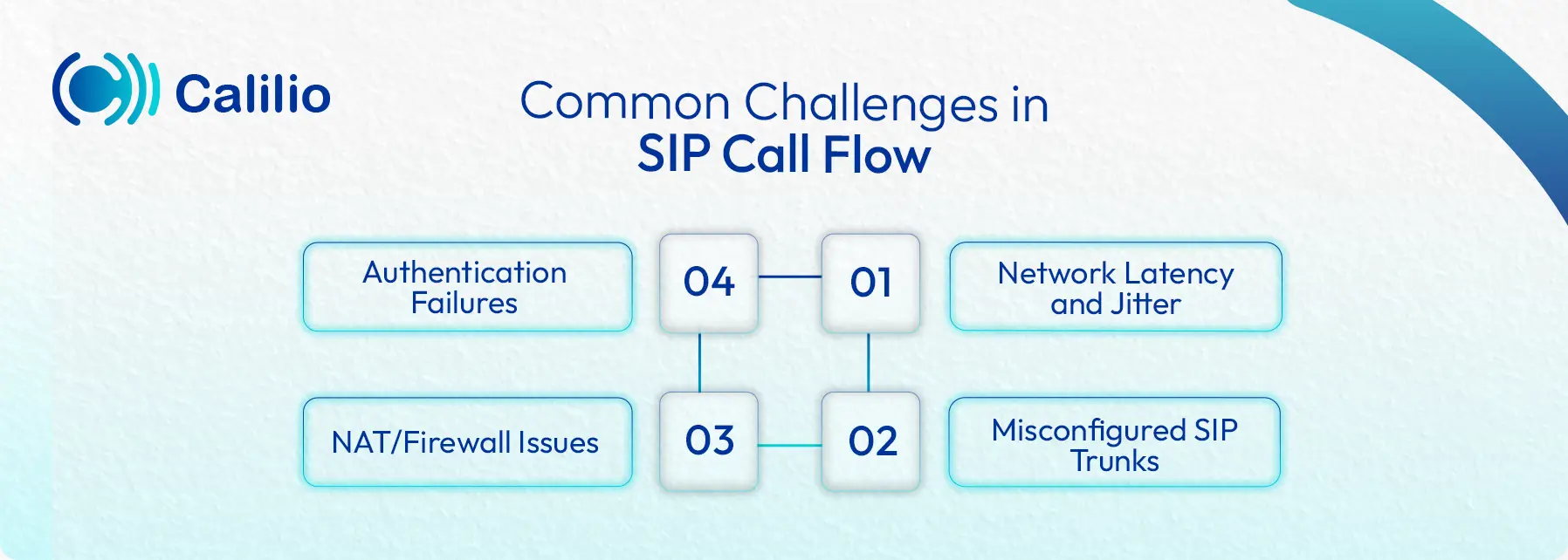SIP Call Flow: Key Components, Challenges & Tips to Optimize

Dropped calls, long connection times, or one-way audio are common problems in internet-based calling. These issues frustrate users and can make even a short conversation difficult.
The problem often comes from how the call is set up and managed. If the signaling between devices isn’t handled properly, calls may not connect smoothly or can end unexpectedly.
SIP call flow provides a simple solution; it defines the step-by-step process for initiating, routing, connecting, and ending calls. By following this structured flow, SIP ensures faster call setup, clear audio and video exchange, and reliable call termination—making communication smoother and more dependable.
In this blog, we’ll explain what SIP call flow is and how it works. We’ll also cover the main SIP codes, key components, common challenges, and simple optimization tips so you can improve VoIP call quality and keep your communication reliable.
Key Highlights:
What is SIP Call Flow?
A SIP call flow is the step-by-step process defined by the Session Initiation Protocol (SIP) for handling an internet call. It describes how a call is initiated, connected, managed during the conversation, and then terminated. In practice, SIP call flow is the exchange of signaling messages that tell the system when to ring, when to connect, how to route the call, and when to end it.
It makes sure both parties can locate each other, exchange voice or video, and properly end the call. In short, SIP call flow is essential for making internet calls smooth and reliable.
How Does SIP Call Flow Work?
A SIP call begins when the caller sends an INVITE, then the network responds with 100 Trying, and the callee’s phone starts ringing (180 Ringing). When the callee answers, a 200 OK is sent, the caller replies with an ACK, media flows through RTP, and finally, the call ends with a BYE followed by 200 OK.
- Call Initiation (INVITE): The caller’s User Agent Client (UAC) sends an INVITE request to initiate a session with the callee. This includes session description details (SDP) such as codecs and media parameters.
- Call Setup/Alerting (180 Ringing): When the recipient User Agent Server (UAS) receives an INVITE, it may reply with 100 Trying to show the request is being processed. Then, it sends 180 Ringing to indicate the call recipient’s device is alerting (ringing) and waiting for the user to answer.
- Call Acceptance (200 OK): When the receiver answers, the UAS sends a 200 OK response, confirming the session parameters (SDP).
- Call Acknowledgment (ACK): The caller (UAC) confirms receipt of the 200 OK by sending an ACK. At this point, the SIP signaling handshake is complete.
- Media Exchange (RTP): Media (voice, video, or other streams) flows directly between endpoints over RTP/RTCP, independent of SIP signaling.
- Call Termination (BYE): When either participant decides to end the session, their device sends a BYE request.
- Termination Acknowledgment (200 OK): The other participant responds with a 200 OK, confirming the call has been terminated.
SIP Call Flow Codes and Their Functions
A SIP call flow is built around a sequence of requests and responses that establish, manage, and end a session. The main components include:
- INVITE: It is sent by the caller to initiate the session and propose media parameters.
- 100 Trying: It is the provisional response confirming the request is being processed.
- 180 Ringing: This code indicates the recipient’s device is alerting the user (ringing).
- 200 OK: This code confirms the call has been accepted and finalizes session details.
- ACK: ACK is code sent by the caller to confirm receipt of the 200 OK and establish the session.
- RTP (Real-Time Transport Protocol): The actual media stream for voice or video exchange.
- BYE: It is sent by either party to end the session.
- 200 OK (for BYE): This code confirms that the call termination request is acknowledged.
Switch to Sip-Based Voip Today for an Advanced Business Phone System
How Does the SIP Call Flow Impact Call Quality?
SIP call flow impacts call quality by influencing call setup speed, media routing, and signaling stability. Properly configured flows ensure fast connections, clear audio with minimal latency or jitter, and reliable call handling from setup to termination.

- Call Setup Speed: The efficiency of SIP signaling directly affects how quickly a call connects. Delays in call setup can frustrate users and create the impression of poor service.
- Audio Quality During the Call: A well-structured SIP call flow ensures that media streams are routed properly, reducing latency, jitter, and packet loss. This leads to clearer and more natural conversations.
- One-Way or Dropped Audio: Improperly configured SIP trunks, firewalls, or NAT settings can interrupt the RTP stream, causing one-way audio or unexpected call drops that disrupt communication.
- Call Reliability: Stable SIP signaling and consistent trunk registration improve overall reliability, reducing the chances of failed connections or mid-call disruptions.
- Call Termination: The call flow also determines how smoothly a call ends. Errors in termination signaling may leave sessions active in the background, consuming resources or preventing new calls from starting.
Key Components of the SIP Call Flow
A SIP call flow works through several connected components. The UAC initiates the request, while the UAS responds, and the Registrar keeps track of user registrations. Meanwhile, the Proxy Server routes requests, the Redirect Server provides alternate paths, and the SBC adds security and quality control.
- User Agent Client (UAC): It is the SIP endpoint that initiates requests, such as a softphone or desk phone making a call.
- User Agent Server (UAS): It is the SIP endpoint that receives and responds to requests, such as a phone answering an incoming call.
- Registrar: It is the server that handles SIP registrations by keeping track of users and mapping their SIP addresses to current IP locations.
- Proxy Server: It is an intermediary that forwards SIP requests and responses between endpoints, ensuring proper routing and call handling.
- Redirect Server: This server informs the caller about an alternative destination, helping reroute calls without forwarding the traffic itself.
- Session Border Controller (SBC): It is a security and control device that protects SIP networks, manages NAT traversal, ensures interoperability, and maintains call quality.
Common Challenges in SIP Call Flow
SIP call flows play a vital role in ensuring smooth and reliable voice communication over IP networks. However, several challenges can disrupt this process, leading to poor call quality or failed connections. For example, network issues like latency and jitter may distort audio, while misconfigured SIP trunks or firewall settings can block calls or cause one-way audio.

Network Latency and Jitter
Network latency and jitter can degrade SIP call quality. Latency causes delays in transmission, while jitter makes packets arrive unevenly. These issues often lead to echoes, robotic voices, or brief audio dropouts, making conversations difficult to follow.
Misconfigured SIP Trunks
When SIP trunking is not configured correctly, it often becomes a major source of call-related issues. Mistakes such as entering the wrong server details, using incorrect ports, or selecting incompatible codecs can lead to failed registrations, dropped calls, or one-way audio where only one side of the conversation is heard.
NAT/Firewall Issue
While Network Address Translation (NAT) and firewalls are essential for network security, they can disrupt SIP traffic if not properly configured. A common scenario is when calls appear connected, but there’s no audio because RTP streams are blocked or misrouted.
Authentication Failures
Incorrect SIP credentials, such as username, password, or domain, prevent proper registration with the provider. This typically causes outbound calls to fail and inbound calls to never reach the user’s phone.
Tips to Optimize Your SIP Call Flow
To keep calls running smoothly, you should keep the setup simple and make sure your SIP lines are working properly. Also, check for errors and stay connected with your provider, and by keeping an eye on calls regularly, you can spot problems like delays or poor sound early and fix them before they get worse.
- Design an efficient call flow: Keep the signaling path simple: Avoid unnecessary hops through multiple proxy servers or gateways, since each extra step adds delay and creates more points of failure.
- Check SIP trunk registration and credentials regularly: Incorrect or expired credentials can prevent calls from connecting. Make sure your SIP trunks are registered correctly and re-authenticate them if needed.
- Analyze call logs for error codes: SIP responses like 4xx (request failure) or 5xx (server error) reveal where problems occur. Reviewing logs helps you identify patterns such as failed INVITEs, unacknowledged responses, or misrouted requests.
- Test connectivity with your SIP provider: Regular test calls can confirm that signaling and RTP streams are working properly. This helps catch provider-side issues or firewall problems before they affect end users.
- Ongoing call monitoring for continuous improvements: Use monitoring tools to track call setup times, jitter, latency, and packet loss. This real-time data makes it easier to spot quality issues early and keep the system reliable.
Conclusion
An optimized SIP call flow is key to smooth and reliable VoIP communication. Moreover, by understanding how calls are initiated, routed, connected, and ended, you can quickly resolve issues. As a result, well-managed flows reduce delays, prevent one-way audio, and keep conversations clear. Ultimately, with the right setup and monitoring, SIP ensures consistent call quality from start to finish.
Your Phone System Just Got Cheaper
Virtual numbers from just $2/month
Call rates starting as low as $0.016/min
The most cost-effective VoIP phone system for businesses
Powered by advanced AI telephony features
Compare low-cost business phone systems
Frequently Asked Questions
Is SIP calling the same as Wi-Fi calling?
SIP calling uses the Session Initiation Protocol to make voice or video calls over any internet connection, while Wi-Fi calling is a carrier feature that routes regular mobile calls through a Wi-Fi network instead of a cellular tower.
How does a SIP system work?

Still have questions?
Can’t find the answer you’re looking for? Please chat with our friendly team.
Stay in the loop
Get the latest call insights, trends, and updates delivered straight to your inbox.
By subscribing, you agree to receive updates from Calilio.
You can unsubscribe anytime.
Phone numbers
Get International Phone Numbers
Singapore
|Australia
|New Zealand